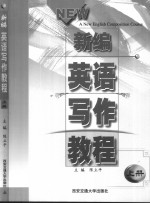

新编英语写作教程 上PDF电子书下载
- 电子书积分:12 积分如何计算积分?
- 作 者:陈立平主编;李志雪等编著
- 出 版 社:西安:西安交通大学出版社
- 出版年份:2002
- ISBN:7560512658
- 页数:327 页
Part Ⅰ Sentence Skills 1
Unit 1 Sentence Fundamentals 1
1.1 Recognize the Sentence 2
1.2 Classify the Sentence 4
Exercises 10
Unit 2 Sentence Agreement and Consistency 13
2.1 Sentence Agreement 14
2.2 Sentence Consistency 20
Exercises 23
Unit 3 Sentence Fragments, Comma Splices and Run-on Sentences 26
3.1 Sentence Fragments 26
3.2 Comma Splices and Run-on Sentences 30
Exercises 34
Unit 4 Sentence Combining-Coordination 37
4.1 Types of Coordination 38
4.2 The Coordinate Sentence 39
4.3 The Function of Coordination 42
4.4 Misuse of Coordination 43
Exercises 45
Unit 5 Sentence Combining-Subordination 48
5.1 Types of Subordination 49
5.2 The Function of Subordination 53
5.3 Ways of Achieving Subordination 54
5.4 Misuse of Subordination 56
5.5 Balance between Subordination and Coordination 57
Exercises 58
Unit 6 Sentence Unity and Coherence 61
6.1 Sentence Unity 61
6.2 Sentence Coherence 65
Exercise 70
Unit 7 Sentence Emphasis 73
7.1 Placement of Important Ideas 74
7.2 Use of Periodic Sentences 74
7.3 Climactic Order 75
7.5 Repetition of Important Words 76
7.4 Use of the Active Voice 76
7.6 Use of Balanced Sentences 77
7.7 Changes in Sentence Length 77
7.8 Use of Cleft Sentences 77
7.9 Inversion of Sentence Order 78
Exercises 79
Unit 8 Sentence Variety 83
8.1 Varied Sentence Lengths 84
8.2 Varied Sentence Structures 89
8.3 Varied Sentence Beginnings 91
8.4 Other Techniques to Vary the Sentence 93
Exercises 94
Unit 9 Sentence Parallelism 98
9.1 What is Parallelism 98
9.2 What Is the Value of Parallelism 99
9.3 How to Achieve Parallelism 100
9.4 How to Avoid Faulty Parallelism 103
Exercises 105
Part Ⅱ Mechanics and Punctuation 109
Unit 10 Mechanics 109
10.1 Spelling 110
10.2 Hyphenation 113
10.3 Capitalization 116
10.4 Numbers 118
10.5 Abbreviations 120
10.6 Italics 123
Exercises 125
Unit 11 Punctuation 128
11.1 The Period,Question Mark and Exclamation Mark 129
11.2 The Comma 130
11.3 The Semicolon 134
11.4 The Colon 135
11.5 Quotation Marks 135
11.6 Other Punctuation Marks 137
Exercises 140
Unit 12 Social Letters 144
Part Ⅲ Practical Writing 144
12.1 The Format of a Social Letter 145
12.2 Ways of Addressing the Envelope 152
12.3 The Language of Social Letters 153
12.4 Types of Social Letters 155
Exercises 172
Unit 13 Business Letters 174
13.1 The Format of a Business Letter 175
13.2 The Language of a Business Letters 183
13.3 Types of Business Letters 185
Exercises 193
Unit 14 Cards,Notes and Notices 195
14.1 Christmas Cards,Postcards,and Visiting Cards 196
14.2 Notes 200
14.3 Notices 203
Exercises 208
15.1 Telegrams 209
Unit 15 Telegrams,Certificates and Résumés 209
15.2 Certificates and Diplomas 212
15.3 Résumés 217
Exercises 221
Unit 16 Writing about Diagrams 222
16.1 Writing about Tables 223
16.2 Writing about Line Graphs 226
16.3 Writing about Bar Graphs 229
16.4 Writing about Pie Charts 231
Exercises 233
Unit 17 Writing about Pictures 236
17.1 Descriptive Type of Picture Writing 237
17.2 Narrative Type of Picture Writing 240
17.3 Expository Type of Picture Writing 242
Exercises 246
Part Ⅳ Précis Writing 249
Unit 18 Guided Précis Writing 249
18.1 Introduction 250
18.2 Guidelines for Précis Writing 251
18.3 Guided Précis Writing Stages 252
Exercise 258
Unit 19 Unguided Précis Writing 261
19.1 The Process of Writing an Unguided Précis 261
19.2 Two Methods to Highlight the Main Points 262
19.3 Strategies to Grasp Main Points 267
Exercises 269
Part V Diction 272
Unit 20 Using the Exact Word 272
20.1 Use the Right Word for Your Meaning 273
20.2 Choose Concrete and Specific Words 275
20.3 Use Standard Idioms 277
20.4 Avoid Worn-out Expressions 278
Exercises 280
Unit 21 Using the Appropriate Word 283
21.1 Levels of Words 284
21.2 Other Kinds of Words 288
Exercises 291
Unit 22 Using Figurative Language 295
22.1 Literal and Figurative Language 296
22.2 Figures of Likeness 297
22.3 Figures of Association 303
22.4 Figures of Arrangement 304
22.5 Figures of Variance 306
Exercises 307
Unit 23 Avoiding Wordiness 309
23.1 Eliminate Wordy Sentence Structures 310
23.2 Eliminate Unneeded Words 314
23.3 Eliminate Unnecessary Repetition 316
23.4 Eliminate Roundabout Expressions 317
Exercises 317
Appendix 321
Symbol Chart for Correction of Composition 321
Bibliography 326
- 《高级英语阅读与听说教程》刘秀梅编著 2019
- 《看图自学吉他弹唱教程》陈飞编著 2019
- 《激光加工实训技能指导理实一体化教程 下》王秀军,徐永红主编;刘波,刘克生副主编 2017
- 《AutoCAD 2019 循序渐进教程》雷焕平,吴昌松,陈兴奎主编 2019
- 《少儿电子琴入门教程 双色图解版》灌木文化 2019
- 《Photoshop CC 2018基础教程》温培利,付华编著 2019
- 《剑桥国际英语写作教程 段落写作》(美)吉尔·辛格尔顿(Jill Shingleton)编著 2019
- 《英语自学进阶教程全6册 3》爱尔兰迪尔德丽出版社著 2019
- 《雅马哈管乐队训练教程 降E调单簧管 分谱》Japan Band Clinic委员会 2019
- 《新编历史小丛书 祖逖北伐》何兹全著 2019
- 《高考快速作文指导》张吉武,鲍志伸主编 2002
- 《建筑施工企业统计》杨淑芝主编 2008
- 《市政工程基础》杨岚编著 2009
- 《家畜百宝 猪、牛、羊、鸡的综合利用》山西省商业厅组织技术处编著 1959
- 《《道德经》200句》崇贤书院编著 2018
- 《钒产业技术及应用》高峰,彭清静,华骏主编 2019
- 《近代旅游指南汇刊二编 16》王强主编 2017
- 《高级英语阅读与听说教程》刘秀梅编著 2019
- 《计算机网络与通信基础》谢雨飞,田启川编著 2019
- 《汉语词汇知识与习得研究》邢红兵主编 2019
